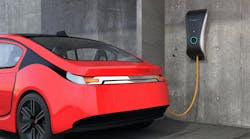Employees at GE's Nela Park campus in East Cleveland, Ohio, recently opened a century-old time capsule that had been buried in the cornerstone of one of the buildings at its famed lighting education facility.
In the time capsule were five light bulbs and some company memorabilia (see article on page 9). GE engineers powered up one of the incandescent bulbs and got it to emit a soft glow. Seeing the gentle light of this incandescent bulb on a YouTube video reminded me of just how far technology has come in the lighting business over the last 100 years. This bulb may not pass the new tough efficiency standards for incandescents, but it emitted the type of light that the latest lighting technologies are trying to attain.
This month's cover story, “Why You Should Learn to Spell OLEDs,” (page 18), explores one of these new technologies. While miles from widespread market implementation, organic light-emitting diodes (OLEDs) dramatically expand the boundaries of what we consider a source of light. OLEDs have been around a while as the display screens on cellphones and televisions. Lighting engineers are now trying to harness their ultra-thin form (the height of two paper clips stacked on top of each other), flexibility and ability to emit a full palette of colors to create thin lighting panels that one day could be manufactured in rolls and installed like wallpaper over ceilings, walls, floors, in furniture, on shelving and even stitched into clothing.
OLEDs are still extraordinarily expensive to produce and to date have just been used in chandeliers for the homes of the super-rich and wall displays in corporate headquarters, airports and other high-end applications. While some naysayers don't think OLEDs will ever pencil out as a real alternative that will cost effectively compete with LEDs and other traditional lighting sources, lighting manufacturers and semiconductor companies are investing millions in R&D because they see potential in OLEDs.
OLEDs are among a handful of new products that have hit the electrical market with a radical new design that makes us stop and rethink our definition of a product segment. These new products don't always succeed, by they always make us take notice. LEDs have certainly redefined what a lighting source looks like, and you could probably say that about compact fluorescent lamps, too. Outside of the lighting market, I always thought the flat-wire undercarpet cabling systems that hit the market in the 1980s had the potential to redefine the wire and cable market. While these systems are still being manufactured today by several electrical manufacturers, including AMP, Hubbell and Thomas & Betts, they never enjoyed the mass-market appeal I was expecting. I will also always remember Square D's Trilliant, a nonmetallic load center launched in the 1990s. It had some interesting features, including a new concept of wire management. Trilliant was heavily promoted by Square D, but it never really gained traction in the market.
It's way too early to say if OLEDs will ever become a cost-effective lighting option or if they will go the way of other new electrical products the market never accepted. One thing's for sure — the market will evaluate them the same as it does any new lighting product. If they can dependably produce better light more cost effectively than other lighting sources, they will be here to stay. The market will decide. That's how it was when that 100-year-old GE incandescent light bulb first rolled off the manufacturing line, and that's how it will be for other products in the future, too.










